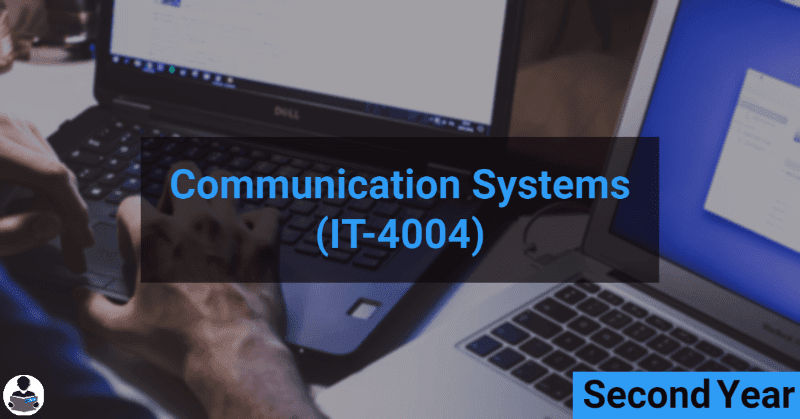Communication Systems (IT-4004)

rgpv bhopal, diploma, rgpv syllabus, rgpv time table, how to get transcript from rgpv, rgpvonline,rgpv question paper, rgpv online question paper, rgpv admit card, rgpv papers, rgpv scheme
RGPV notes CBGS Bachelor of engineering
Course Objectives:
The study of communication systems starts with the concept of analog communication. In this course time and frequency representation of information is given. The objective of this course is to be familiar with the basic building blocks of communication systems such as modulator and demodulator. Different types of analog modulation techniques are given in this course.
Syllabus
UNIT 1:
Signals and Systems: Block diagram of a communication system, signal-definition, types of
signals continuous, discrete, deterministic, non-deterministic, periodic, non-periodic, energy,
power, analog and digital signals. Electromagnetic Spectra, Standard signals- DC, sinusoidal,
unit step, ramp, signum, rectangular pulse, impulse(delta) signal. System definition,
classification of systems, linear, nonlinear, time variant, time invariant, causal, non causal, stable
and unstable systems. Transmission media-Guided and unguided media, twisted pair, Unshielded
twisted pair and Shielded twisted pair, coaxial cable and fiber optic cable, radio waves,
microwaves and infrared transmission.
UNIT 2:
Fourier transforms: Time domain and frequency domain representation of signal, Fourier
Transform and its properties, conditions for existence, Transform of Gate, unit step, constant,
impulse, sine and cosine wave. Shifting property of delta function, convolution, time and
frequency convolution theorems.
UNIT 3:
Amplitude modulation: Modulation, need of modulation, types of modulation techniques,
amplitude modulation (DSB-FC), modulation index, frequency spectrum of AM wave, linear and
over modulation, power relation in AM, transmission efficiency, modulation by a complex
signal, bandwidth of AM, AM modulators, square law and switching modulator, advantages and
disadvantages of AM.
UNIT 4:
Demodulation of AM: Suppressed carrier amplitude modulation systems, DSB-SC, SSB-SC,
VSB-SC systems, comparison of various amplitude modulation systems. Demodulation of AM,
square law and envelope detector, synchronous detection of AM, Low and high power AM
transmitters, AM receivers, TRF and superheterodyne receivers, sensitivity, selectivity and
fidelity of receivers.
UNIT 5:
Angle modulation: Introduction and types of angle modulation, frequency modulation, frequency
deviation, modulation index, deviation ratio, bandwidth requirement of FM wave, types of FM.
Phase modulation, difference between FM and PM, Direct and indirect method of FM
generation, FM demodulators- slope detector, Foster seeley discriminator, ratio detector.
Introduction to pulse modulation systems, PAM, PPM, PWM systems, frequency and time
division multiplexing.
NOTES
- Unit 1
- Unit 2
- Unit 3
- Unit 4
- Unit 5
Books Recommended
At the end of this course students will be able to understand the communication of information over the communication channel. Students will understand how information signal of low frequency can be transmitted with the help of modulation techniques over a long distance. Students will be able to differentiate different modulation techniques such as AM, SSB, DSB and FM.
Books Recommended
1. Singh & Sapre, “Communication Systems”, TMH.
2. W. Tomasi “Electronic Communications Systems”, Pearson Education Pvt. Ltd.
3. Taub & shilling, “Communication Systems”, TMH.
4. Abhay Gandhi, “Analog and Digital Communication”, CENGAGE Learning.
List of Experiments:
1. AM Modulation and Demodulation (Envelope Detector)
2. Frequency modulation using reactance modulator.
3. Frequency modulation using varactor modulator.
4. Pulse Amplitude Modulation and Demodulation
5. Pre-emphasis and De-emphasis
6. Analog Multiplexing.
7. Amplitude Modulation using Pspice
8. Receiver characteristics (selectivity, sensitivity, fidelity).
9. Operation of foster-seeley loop detector.
10. Operation of ratio detector.
You May Also Like
- ES-3001 - Energy, Environment, Ecology & Society
- IT-4002 - Data Base Management System
- IT-4003 - Operating System
- IT-4005 - Computer Architecture
- IT-4006 - Computer Programming-II (Dot Net Technology)
- IT-4007 - Programming Tools (Internal Assessment)
- IT-4008 - Professional Ethics (Internal Assessment)



